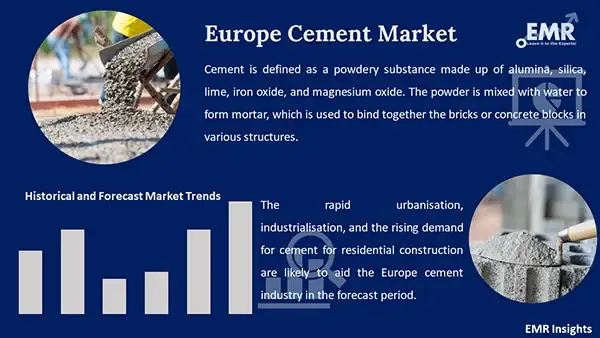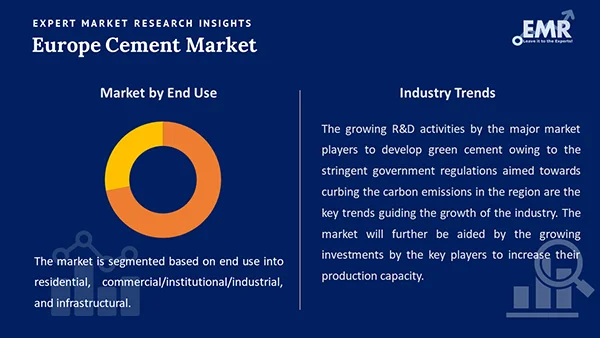
Consumer Insights
Uncover trends and behaviors shaping consumer choices today
Procurement Insights
Optimize your sourcing strategy with key market data
Industry Stats
Stay ahead with the latest trends and market analysis.
The Europe cement market stood at a volume of around 179.94 MMT in 2025. The market is further expected to witness a CAGR of 1.90% in the forecast period of 2026-2035.
Base Year
Historical Period
Forecast Period
Compound Annual Growth Rate
1.9%
Value in MMT
2026-2035
*this image is indicative*
The residential construction sector in Europe is witnessing a healthy growth owing to the rising disposable income, rapid urbanisation, increasing immigration in the cities, rising standards of living, and increasing inclination towards aesthetic houses. In addition to this, the rising investments in multi-housing projects in Europe is anticipated to aid the market. For instance, in the third quarter of 2021, a construction project named ZAC Campus Grand Parc Mixed-Use Development was started and is likely to finish in the last quarter of 2027. Some other multifamily housing construction projects in Europe include Milanosesto Mixed-Use Complex, Camden Goods Yard Mixed-Use Community, and Viadux Mixed-Use Community, among others. Hence, the residential sector in the region is anticipated to grow at a significant rate in the forecast period.

Read more about this report - REQUEST FREE SAMPLE COPY IN PDF
Germany is one of the largest producers of cement in Europe and is likely to maintain its dominance over the region in the forecast period. This can be attributed to the rising investments in a number of construction projects and the rapid development of infrastructure in the region. Praille-Acacias-Vernets (PAV) is a major construction project in Geneva, where a significant number of workforce is employed and the project’s major construction stages are expected to lead to an increased consumption of cement in the forecast period. Moreover, large cement plants are located in this country such as Holcim Ltd, Vicat Group, and CRH PLC, among others. Hence, the cement market in the country is anticipated to witness a steady growth in the forecast period.
Cement is defined as a powdery substance made up of alumina, silica, lime, iron oxide, and magnesium oxide. The powder is mixed with water to form mortar, which is used to bind together the bricks or concrete blocks in various structures. Cement is a binder material and its major applications include residential, commercial, and industrial structures, among others.
Based on end use, the market can be segmented into
Market Breakup by Region

Read more about this report - REQUEST FREE SAMPLE COPY IN PDF
The regional markets for the product include Germany, the United Kingdom, France, Italy, Spain, Switzerland, Poland, and Netherlands, among others.
The expansion of the building and construction industry in Europe owing to the rising population, increasing standards of living, strong foot hold of major construction companies, and rising investments in the infrastructural development projects is driving the market growth. Additionally, the growing efforts by the government in France, Spain, Switzerland, Poland, and Germany to improve road networks are likely to be a major aiding factor in the market growth. Moreover, cement is very economical as the production cost of the material is low as compared to its counterparts. This is another key driving factor in the market, propelling the demand for cement in the region. Furthermore, the expansion of automotive, military and defence, and clothing industries in Europe is likely to accelerate the construction of manufacturing plants, which, in turn, is expected to boost the demand for cement in the forecast period. The market in the region will further be aided by the changing preference of engineers and architects towards construction materials with high temperature resistance in order to bolster the comfort of the occupants.
The report gives a detailed analysis of the following key players in the Europe cement market, covering their competitive landscape, capacity, and latest developments like mergers, acquisitions, and investments, expansions of capacity, and plant turnarounds:
The comprehensive EMR report provides an in-depth assessment of the market based on the Porter's five forces model along with giving a SWOT analysis.
Africa Green Cement and Concrete Market
North America Bone Cement Market
Asia Pacific Bone Cement Market
Europe White Cement Market
Europe Bone Cement Market
White Cement Market
Green Cement Market
MENA Cement Market
Bone Cement Market
Cement Market




*While we strive to always give you current and accurate information, the numbers depicted on the website are indicative and may differ from the actual numbers in the main report. At Expert Market Research, we aim to bring you the latest insights and trends in the market. Using our analyses and forecasts, stakeholders can understand the market dynamics, navigate challenges, and capitalize on opportunities to make data-driven strategic decisions.*
Get in touch with us for a customized solution tailored to your unique requirements and save upto 35%!
In 2025, the Europe cement market attained a volume of nearly 179.94 MMT.
The major drivers of the market include the rapid urbanisation, increasing investments in multi-housing projects, strong foothold of major construction companies in the region, thriving commercial construction sector, and rising disposable income.
The growing R&D activities by the major market players to develop green cement owing to the stringent government regulations aimed towards curbing the carbon emissions in the region are the key trends guiding the growth of the industry.
The major regions in the industry are Germany, the United Kingdom, France, Italy, Spain, Switzerland, Poland, and Netherlands, among others.
Residential, commercial/institutional/industrial, and infrastructural, among others are the major end uses of the product.
The major players in the industry are Holcim Ltd., HeidelbergCement AG, CRH plc, Vicat Group, Buzzi Unicem SpA., CEMEX, S.A.B. de C.V, Cementir Holding N.V., and Titan Cement International S.A., among others.
Explore our key highlights of the report and gain a concise overview of key findings, trends, and actionable insights that will empower your strategic decisions.
| REPORT FEATURES | DETAILS |
| Base Year | 2025 |
| Historical Period | 2019-2025 |
| Forecast Period | 2026-2035 |
| Scope of the Report |
Historical and Forecast Trends, Industry Drivers and Constraints, Historical and Forecast Market Analysis by Segment:
|
| Breakup by End Use |
|
| Breakup by Region |
|
| Market Dynamics |
|
| Competitive Landscape |
|
| Companies Covered |
|
| Report Price and Purchase Option | Explore our purchase options that are best suited to your resources and industry needs. |
| Delivery Format | Delivered as an attached PDF and Excel through email, with an option of receiving an editable PPT, according to the purchase option. |
Datasheet
One User
USD 2,999
USD 2,699
tax inclusive*
Single User License
One User
USD 4,839
USD 4,355
tax inclusive*
Five User License
Five User
USD 5,999
USD 5,099
tax inclusive*
Corporate License
Unlimited Users
USD 7,259
USD 6,170
tax inclusive*
*Please note that the prices mentioned below are starting prices for each bundle type. Kindly contact our team for further details.*
Flash Bundle
Small Business Bundle
Growth Bundle
Enterprise Bundle
*Please note that the prices mentioned below are starting prices for each bundle type. Kindly contact our team for further details.*
Flash Bundle
Number of Reports: 3
20%
tax inclusive*
Small Business Bundle
Number of Reports: 5
25%
tax inclusive*
Growth Bundle
Number of Reports: 8
30%
tax inclusive*
Enterprise Bundle
Number of Reports: 10
35%
tax inclusive*
How To Order

Select License Type
Choose the right license for your needs and access rights.

Click on ‘Buy Now’
Add the report to your cart with one click and proceed to register.

Select Mode of Payment
Choose a payment option for a secure checkout. You will be redirected accordingly.
Gain insights to stay ahead and seize opportunities.

Get insights & trends for a competitive edge.

Track prices with detailed trend reports.

Analyse trade data for supply chain insights.

Leverage cost reports for smart savings

Enhance supply chain with partnerships.

Connect For More Information
Our expert team of analysts will offer full support and resolve any queries regarding the report, before and after the purchase.
Our expert team of analysts will offer full support and resolve any queries regarding the report, before and after the purchase.
We employ meticulous research methods, blending advanced analytics and expert insights to deliver accurate, actionable industry intelligence, staying ahead of competitors.
Our skilled analysts offer unparalleled competitive advantage with detailed insights on current and emerging markets, ensuring your strategic edge.
We offer an in-depth yet simplified presentation of industry insights and analysis to meet your specific requirements effectively.
Share